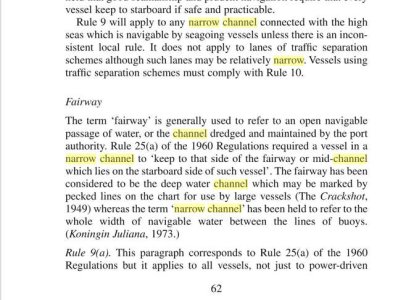jfm
Well-known member
Many thanks for all the replies.
BTW, this is not a CBD situation, as explained correctly in #10 and #15.
In replying I'm debating whether to reply softly softly and leave it at that, or push back against a few trite replies that make a little speech while ignoring the actual question, or make something up (eg that I need to resort to the internet), or suggest the Hamble isn't a narrow channel, or show a shocking mis-reading/mis-understanding of Colregs (not everyone of course, but plenty). I'll go with the former, so many thanks for the replies!
Fascinating to see so much confirmation bias in many replies - people want somehow to say the mobo needs to give way, so they scour the rules for that answer. Post 33 creatively says the Mobo is never RAM, and that the sailing dinghy might too need to be in the channel, both of which are 100% true but utterly irrelevant to the question asked or to the Colregs under consideration here, but serve the confirmation bias well. Post #37 inexplicably just decides Rule 9 isn't relevant here (it favours the mobo, but if it favoured the sailing boat I'm sure it would be re-instated!) Others cite good ole Rule 2 as a last resort to make the mobo the give way guy. Very very interesting reading!
I expect to get flamed Just saying it as I see it
Just saying it as I see it 
BTW, this is not a CBD situation, as explained correctly in #10 and #15.
In replying I'm debating whether to reply softly softly and leave it at that, or push back against a few trite replies that make a little speech while ignoring the actual question, or make something up (eg that I need to resort to the internet), or suggest the Hamble isn't a narrow channel, or show a shocking mis-reading/mis-understanding of Colregs (not everyone of course, but plenty). I'll go with the former, so many thanks for the replies!
Fascinating to see so much confirmation bias in many replies - people want somehow to say the mobo needs to give way, so they scour the rules for that answer. Post 33 creatively says the Mobo is never RAM, and that the sailing dinghy might too need to be in the channel, both of which are 100% true but utterly irrelevant to the question asked or to the Colregs under consideration here, but serve the confirmation bias well. Post #37 inexplicably just decides Rule 9 isn't relevant here (it favours the mobo, but if it favoured the sailing boat I'm sure it would be re-instated!) Others cite good ole Rule 2 as a last resort to make the mobo the give way guy. Very very interesting reading!
I expect to get flamed
Last edited:

